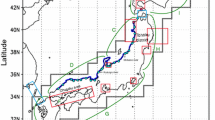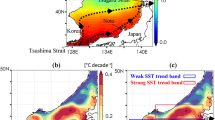Abstract
The role of meso-scale eddies and coastal currents in marine and climatic environmental studies is of great importance. In this study, the coastal currents of the Persian Gulf and their effect on the formation of meso-scale eddies and the spread of pollution were simulated using the COHERENS numerical model with a horizontal resolution of longitude and latitude of 2 min. The simulation results indicated that the velocity of the currents was low from January to March and began to increase in May. This trend continued until June and July and then began to decline in August. The most activity of eddies was in the inlet parts of the Persian Gulf starting including the Strait of Hormuz and the northwest of the Persian Gulf; therefore, they were the most dangerous parts of the region regarding the spread of pollution. Moreover, sea surface height field data were extracted from AVISO dataset for 5 years (2015–2019), and meso-scale eddies were identified and tracked based on sea surface height using Arc GIS software. The strongest eddies were observed in summer. According to the simulation results, the currents of the Iranian coast extended to the northwest from January to April and reached their maximum intensity from June to August. Therefore, the pollution was spread in the north of the Persian Gulf along the coasts of Iran, and July was recognized as the most dangerous time for the spread of pollution.












Similar content being viewed by others
Abbreviations
- c p :
-
Specific heat of water at constant pressure
- f :
-
Coriolis parameter
- I :
-
Absorption of sunlight in the water column (W/m2)
- P :
-
Pressure (N/m2)
- S :
-
Salinity (psu)
- t :
-
Time (s)
- T :
-
Temperature (C)
- \(\upsilon_{{\text{T}}}\) :
-
Eddy viscosity
- \(\rho\) :
-
Density (kg/m3)
- \(\rho_{0 } \) :
-
Reference density (kg/m3)
- \(\lambda_{{\text{H}}}\) :
-
Horizontal diffusion coefficient for salinity and temperature
- \(\lambda_{{\text{T}}}\) :
-
Vertical diffusion coefficient for salinity and temperature
References
Al Azhar M, Temimi M, Zhao J, Ghedira H (2016) Modeling of circulation in the Arabian Gulf and the Sea of Oman: skill assessment and seasonal thermohaline structure. J Geophys Res Ocean 121(3):1700–1720. https://doi.org/10.1002/2015jc011038
Al Shehhi MR, Gherboudj I, Ghedira H (2014) An overview of historical harmful algae blooms outbreaks in the Arabian Seas. Mar Pollut Bull 86(1–2):314–324. https://doi.org/10.1016/j.marpolbul.2014.06.048
Alessi CA, Hunt HD, Bower AS (1999) Hydrographic data from the US Naval Oceanographic Office: Persian Gulf, Southern Red Sea, and Arabian Sea 1923–1996 (No. WHOI-99–02). Woods Hole Oceanographic Institution (WHOI)
Arakawa A, Suarez MJ (1983) Vertical differencing of the primitive equations in sigma coordinates. Mon Weather Rev 111(1):34–45. https://doi.org/10.1175/1520-0493(1983)111%3c0034:vdotpe%3e2.0.co;2
Brach L, Deixonneb P, Bernardb M, Durand E, Desjeand M, Pereza E, Sebille E, Hallea A (2018) Anticyclonic eddies increase accumulation of microplastic in the North Atlantic subtropical gyre. Mar Pollut Bull 126:191–196. https://doi.org/10.1016/j.marpolbul.2017.10.077
Busireddy NKR, Osuri KK, Sivareddy S, Venkatesan R (2018) An observational analysis of the evolution of a mesoscale anti-cyclonic eddy over the Northern Bay of Bengal during May–July 2014. Ocean Dyn 68(11):1431–1441. https://doi.org/10.1007/s10236-018-1202-4
Chelton DB, Schlax MG, Samelson RM (2011) Global observations of nonlinear meso-scale eddies. Prog Oceanogr 91:167–216. https://doi.org/10.1016/j.pocean.2011.01.002
Dandapat S, Chakraborty A (2016) Mesoscale eddies in the Western Bay of Bengal as observed from satellite altimetry in 1993–2014: statistical characteristics, variability and three dimensional properties. IEEE J Sel Top Appl Earth Observ Remote Sens 9(11):5044–5054. https://doi.org/10.1109/jstars.2016.2585179
Essa S, Harahsheh H, Shiobara M, Nishidai T (2005) Operational remote sensing for the detection and monitoring of oil pollution in the Arabian Gulf: case studies from the United Arab Emirates. Developments in earth and environmental sciences. Elsevier, Amsterdam, pp 31–48
Frenger I, Gruber N, Knutti R, Münnich M (2013) Imprint of Southern Ocean eddies on winds, clouds and rainfall. Nat Geosci 6(8):608–612. https://doi.org/10.1038/ngeo1863
Gopalan AKS, Krishna VV, Ali MM, Sharma R (2000) Detection of Bay of Bengal eddies from TOPEX and in situ observations. J Mar Res 58(5):721–734. https://doi.org/10.1357/002224000321358873
Haj Rasouliha O, Hasanzadeh E, Rezaei Latifi A (2013) The role of physical processes in ways of oil pollutions distribution in the Persian Gulf. J Clim Res 15:93–106
Johns WE, Yao F, Olson DB, Josey SA, Grist JP, Smeed DA (2003) Observations of seasonal exchange through the Straits of Hormuz and the inferred heat and freshwater budgets of the Persian Gulf. J Geophys Res Ocean 108(C12):1–18. https://doi.org/10.1029/2003jc001881
Kämpf J, Sadrinasab M (2006) The circulation of the Persian Gulf: a numerical study. Ocean Sci 2(1):27–41. https://doi.org/10.5194/os-2-27-2006
Kumar PS, Muraleedharan PM, Prasad TG, Gauns M, Ramaiah N, De Souza SN et al (2002) Why is the Bay of Bengal less productive during summer monsoon compared to the Arabian Sea? Geophys Res Lett 29(24):88. https://doi.org/10.1029/2002gl016013
Lardner RW, Al-rabeh A H, Guna N, Hossain M, Reynolds RM et al (1993) Computation of the residual flow in the ROPME Sea Area using the Mt-Mitchell data and KFUPM/RI hydrodynamical models, Final report of the Mt-Mitchell cruise in the ROPME Sea Area, pp 116–150
Luyten PJ, Deleersnijder E, Ozer J, Ruddick KG (1996) Presentation of a family of turbulence closure models for stratified shallow water flows and preliminary application to the Rhine outflow region. Cont Shelf Res 16(1):101–130. https://doi.org/10.1016/0278-4343(95)93591-v
Luyten PJ, Jones JE, Proctor R, Tabor A, Tett P, Wild-Allen K (1999) COHERENS–a coupled hydrodynamical-ecological model for regional and shelf seas: user documentation. MUMM Report, Management Unit of the Mathematical Models of the North Sea, 914
Mehrfar H, Torabi Azad M, Lari K, Bidokhti AA (2020a) Seasonal variations of the coastal currents and Eddies in the Persian Gulf: a numerical case study. Mar Technol Soc J 54(1):44–52. https://doi.org/10.4031/mtsj.54.1.4
Mehrfar H, Torabi Azad M, Lari K, Bidokhti AA (2020b) A numerical simulation case study of the coastal currents and upwelling in the western Persian Gulf. J Ocean Eng Sci 5(4):323–332. https://doi.org/10.1016/j.joes.2019.12.005
Mellor GL, Yamada T (1982) Development of a turbulence closure model for geophysical fluid problems. Rev Geophys 20(4):851–875. https://doi.org/10.1029/rg020i004p00851
Mohandesi NM, Bidokhti AA, Khaniki AK, Zadeh IH, Azad MT (2016) A Study of the performances of different turbulence schemes in numerical simulation of hydrodynamics of a semi-closed sea (Persian Gulf). Mar Geod 39(2):141–164. https://doi.org/10.1080/01490419.2015.1134736
Noori R, Abbasi MR, Adamowski JF, Dehghani M (2017) A simple mathematical model to predict sea surface temperature over the northwest Indian Ocean. Estuar Coast Shelf Sci 197:236–243. https://doi.org/10.1016/j.ecss.2017.08.022
Noori R, Fuqiang T, Ronny B, Abbasi MR, VesaliNaseh MR, Modabberi A, Soltani A, Klove B (2019) Recent and future trends in sea surface temperature across the Persian Gulf and Gulf of Oman. PLoS ONE 14(2):e0212790. https://doi.org/10.1371/journal.pone.0212790
Pous S, Lazure P, Carton X (2015) A model of the general circulation in the Persian Gulf and in the Strait of Hormuz: intraseasonal to interannual variability. Cont Shelf Res 94:55–70. https://doi.org/10.1016/j.csr.2014.12.008
Raeisi A, Bidokhti AA, Nazemossadat SMJ, Lari K (2020a) The study of mesoscale eddies and their dispersive environmental impacts in the Persian Gulf. Chin Phys B 29(8):084701. https://doi.org/10.1088/1674-1056/ab96a3
Raeisi A, Bidokhti AA, Nazemossadat SMJ, Lari K (2020b) Impact of mesoscale eddies on climate and environmental changes in the Persian Gulf. Res Mar Sci 5(4):823–832
Reynolds RM (1993) Physical oceanography of the Gulf, Strait of Hormuz, and the Gulf of Oman—results from the Mt Mitchell expedition. Mar Pollut Bull 27:35–59. https://doi.org/10.1016/0025-326x(93)90007-7
Richlen ML, Morton SL, Jamali EA, Rajan A, Anderson DM (2010) The catastrophic 2008–2009 red tide in the Arabian gulf region, with observations on the identification and phylogeny of the fish-killing dinoflagellate Cochlodinium polykrikoides. Harmful Algae 9(2):163–172. https://doi.org/10.1016/j.hal.2009.08.013
Risk MJ, Haghshenas SA, Razavi Arab A (2021) Cage aquaculture in the Persian Gulf: a cautionary tale for Iran and the world. Mar Pollut Bull 166:112079. https://doi.org/10.1016/j.marpolbul.2021.112079
Soliman YS, Alansari EMA, Sericano JL, Wade TL (2019) Spatio-temporal distribution and sources identifications of polycyclic aromatic hydrocarbons and their alkyl homolog in surface sediments in the central Arabian Gulf. Sci Total Environ 658:787–797. https://doi.org/10.1016/j.scitotenv.2018.12.093
Swift SA, Bower AS (2003) Formation and circulation of dense water in the Persian/Arabian Gulf. J Geophys Res Ocean 108(C1):1–4. https://doi.org/10.1029/2002jc001360
Thoppil PG, Hogan PJ (2009) On the mechanisms of episodic salinity outflow events in the Strait of Hormuz. J Phys Oceanogr 39(6):1340–1360. https://doi.org/10.1175/2008jpo3941.1
Torabi Azad M, Mehrfar H (2017) Seasonal variation of coastal jets in the Persian Gulf using field studies. Res Mar Sci 3:106–117
Vasou P, Vervatis V, Krokos G, Hoteit I, Sofianos S (2020) Variability of water exchanges through the Strait of Hormuz. Ocean Dyn 70:1053–1065. https://doi.org/10.1007/s10236-020-01384-2
Yao F, Johns WE (2010a) A HYCOM modeling study of the Persian Gulf: 2. Formation and export of Persian Gulf water. J Geophys Res Ocean 115(C11):1–23. https://doi.org/10.1029/2009jc005788
Yao F, Johns WE (2010b) A HYCOM modeling study of the Persian Gulf: 1. Model configurations and surface circulation. J Geophys Res 115(C11017):1–17. https://doi.org/10.1029/2009jc005781
Zhao J, Ghedira H (2014) Monitoring red tide with satellite imagery and numerical models: a case study in the Arabian Gulf. Mar Pollut Bull 79(1–2):305–313. https://doi.org/10.1016/j.marpolbul.2013.10.057
Zhao J, Temimi M, Ghedira H, Hu C (2014) Exploring the potential of optical remote sensing for oil spill detection in shallow coastal waters-a case study in the Arabian Gulf. Opt Express 22(11):13755–13772. https://doi.org/10.1364/oe.22.013755
Zhao J, Temimi M, Al Azhar M, Ghedira H (2015) Satellite-based tracking of oil pollution in the Arabian Gulf and the Sea of Oman. Can J Remote Sens 41(2):113–125. https://doi.org/10.1080/07038992.2015.1042543
Acknowledgements
We also thank Dr. Amir Siah Sarani (Ocean Modeling Office, Tehran Forecasting Center, I.R.IRAN of Meteorological Organization) for providing us technical supports.
Funding
The authors received no financial support for the research of this article. The authors declare that they have no conflict of interest to the publication of this article.
Author information
Authors and Affiliations
Contributions
The author confirms sole responsibility for the following: study conception and design, data collection, analysis and interpretation of results, and manuscript preparation.
Corresponding author
Ethics declarations
Conflict of interest
The authors received no financial support for the research of this article. The authors declare that they have no conflict of interest to the publication of this article.
Additional information
Editorial responsibility: Jing Chen.
Rights and permissions
Springer Nature or its licensor (e.g. a society or other partner) holds exclusive rights to this article under a publishing agreement with the author(s) or other rightsholder(s); author self-archiving of the accepted manuscript version of this article is solely governed by the terms of such publishing agreement and applicable law.
About this article
Cite this article
Mehrfar, H., Raeisi, A., Azad, M.T. et al. Numerical study of the effects of coastal currents and meso-scale eddies on the spread of pollution in the Persian Gulf. Int. J. Environ. Sci. Technol. 20, 7099–7116 (2023). https://doi.org/10.1007/s13762-023-04920-x
Received:
Revised:
Accepted:
Published:
Issue Date:
DOI: https://doi.org/10.1007/s13762-023-04920-x




